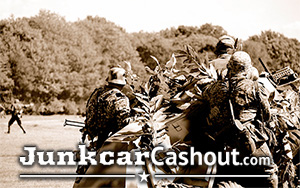When the Japanese attacked Pearl Harbor on December 7, 1941, Americans' feelings about WWII shifted drastically from apathy to rage. Volunteers sprung into action, offering their patriotic support in any way they could. From joining the service to keeping vigilante watch at home, planting victory gardens to buying bonds, Americans embraced their nationalist duties in a number of ways. Perhaps the most memorable, though, was citizens' compliance with government-mandated rations.
Patriotic Rationing
With our entrance into the war, the government implemented control over how much of a certain product people could buy--even if they could afford it. As peace time production adjusted to meet the demands of battle, everyday items became scare overnight. Authorities pleaded with Americans to conserve, but in order to keep things fair, they distributed ration stamps.
Many Americans who lived during WWII can vividly recall food rationing. Sugar, butter, meats, canned and frozen vegetables, and other staples could only be purchased in small quantities via the coupon allowance system. Soldiers overseas needed food, and in some cases, production halted altogether to make way for wartime manufacturing. Being a "good," patriotic American meant not selling or buying goods on the black market. Government propaganda reminded consumers to use their ration stamps responsibly.
Metal and Other Resource Rationing
People tend to forget, though, that WWII rationing also extended into other goods including vehicles, farm equipment, office machinery, home appliances, and even the simplest of basic metal goods that could contribute to military manufacturing. The American government rationed the following items and materials during the war:
- • cars
- • bicycles
- • tires
- • automobile parts
- • stoves and other appliances
- • typewriters
- • plows
- • chicken wire
- • tractors
- • windmills
- • rubber footwear
- • metal containers like toothpaste tubes
- • paper
- • silk and nylon
The Wartime Value of Scrap Metal
Today, the scrap metal industry is as lucrative as ever, and most Americans understand the value of responsible recycling. But during WWII, preserving and re-purposing any source of metal was literally the difference between life and death. Just one shovel could be turned into four hand grenades; one old disc could yield steel for 210 semi-automatic light carbines; 125 pounds of random rusty metal, when mixed with other materials, could make a 500 pound aerial bomb.
During WWII, experts estimate that roughly 1.5 million tons of unused scrap metal were stored on farms across America. These resources were enough to build 139 modern navy battleships. So, alongside rationing, Americans became aware of how collecting even the smallest hoard of scrap material might help the war effort. In some extreme cases, citizens saved their gum wrappers, growing tin foil balls until they were large enough to contribute to collection sites.
Scrap Metal Drives
Unlike WWI, the highly mobile nature of the Second World War meant America needed more large-scale vehicles and weaponry. Thousands of tons of metal were required for just a small fleet of tanks, ships, or planes. A single tank alone needed 18 tons, and the navy's massive ships up to 900 tons each. Everyday metal materials from vegetable cans to chicken wire were rationed, but patriotic citizens did more.
The government--and even celebrities--advertised heavily for upstanding Americans to turn in their spare scrap metal and other items. With compliance, the military could recycle unused materials to save resources and money. Schools, churches, and other community groups rallied their citizens, holding drives to drum up awareness and collect materials for the cause. American patriots gathered and recycled rusted metal scraps, dirty rags, paper, rubber, and more.
Trolley Track Excavations
Shortages in supplies led Americans to go to even greater lengths to support their country. In Asheville, North Carolina, community members dug up the since paved streets to retrieve old trolley tracks. To justify the hassle, advertisers came up with catchy slogans appealing to people's nationalism: "It's no good underground, but it can be used to Smash the Axis!" In other high profile campaigns, the government solicited celebrities in their advertising efforts. In one image, popular actress Rita Hayworth poses on top of a car with the caption, "Please drive carefully: My bumpers are on the scrap heap."
America may not need scrap metal for the same reasons it did during WWII, but to learn more about the modern benefits of recycling, talk to the team at Junk Car Cash Out. We offer top dollar payouts and free tow away of all your small and large scrap metal in the Salt Lake City area. Call us today--it's your patriotic duty!





























